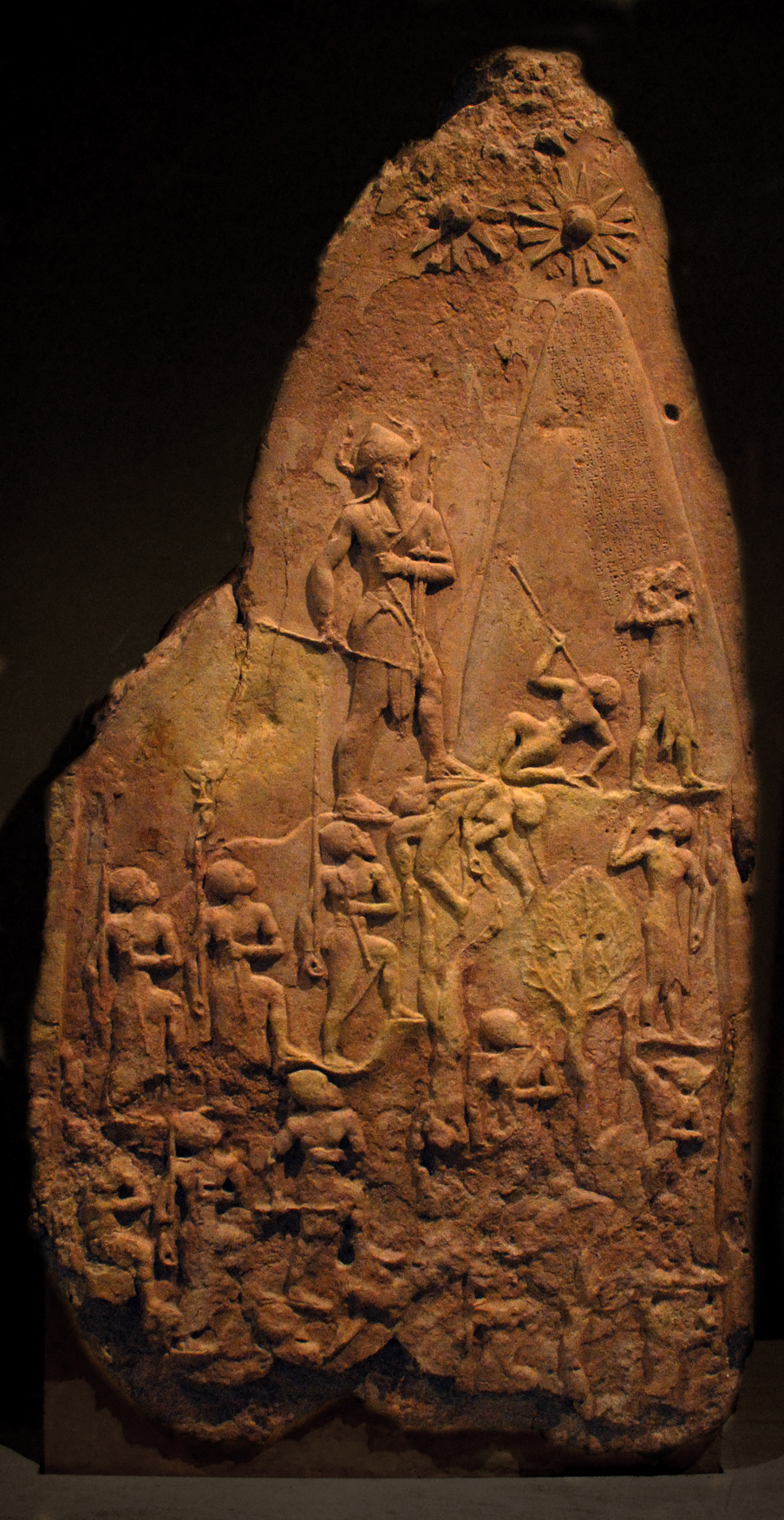Victory Stele of Naram-Sin, king of Akkad. Circa 2250 BC. CC BY-NC-SA, Jan van der Crabben via Ancient History Encyclopedia.
- Spicular limestone; H. 2 m; W. 1.5 m
- J. de Morgan excavations, 1898 , 1898
Sb 4 - Location: Near Eastern Antiquities
Richelieu wing
Ground floor
Mesopotamia, c. 2350–2000 BC
Room 2
It was brought from Sippar to Susa in the 12th century BC, was restored in 1992 AD and it is currently displayed in the Louvre Museum, Paris.
Wikipedia says:
The Victory Stele of Naram-Sin is a stele that dates to approximately 2254-2218 BC, in the time of the Akkadian Empire. The relief measures six feet in height and was carved in pink limestone. It depicts the King Naram-Sin of Akkad leading the Akkadian army to victory over the mountain people, the Lullubi. It shows a narrative of the King crossing the steep slopes into enemy territory; on the left are the ordered imperial forces keeping in rank while marching over the disordered defenders that lay broken and defeated. Naram-Sin in shown as by far the most important figure; he is shown towering over his enemy and troops and all eyes gaze up toward him. The weak and chaotic opposing forces are shown being thrown from atop the mountainside, impaled by spears, fleeing and begging Naram-Sin for mercy as well as being trampled underfoot by Naram-Sin himself. This is supposed to convey their uncivilized and barbaric nature making the conquest justified.[1]
The stele is unique in two regards. Most conquest depictions are shown horizontally, with the King being at the top-center. This stele depicts the victory in a diagonal fashion with the King still being at the top-center but where everyone else can look up to him. The second unique aspect of the piece is that Naram-Sin is shown wearing a bull-horned helmet. Helmets of this type at the time when this stele was commissioned were only worn by the Gods. This stele is in essence telling the viewer that Naram-Sin is a victorious conqueror as a result of his divine status. But it also shows Naram-Sin gazing up toward two stars. Showing that although Naram-Sin is a god, a feat that was up to this point only achieved by deceased kings, he is still not the most powerful of gods.
This is a video on this stele by the Khan Academy:
From the video (2:30, emphasis mine):
And so we see Naram-Sin, much larger than everyone else, with his shoulders frontal, his head in profile, and close to the deities at the top, who are represented by what look like suns. The suns, or the stars above, are the forces that have helped guide him to victory. But also, and this is important, he’s wearing a horned helmet, which is for the Akkadians a symbol of divinity. So through his victory he is actually assuming the importance and the status of the gods. And in fact, the whole ascension to the mountaintop certainly supports this idea. He is rising into the realm of the heavenly.
This idea that men recreate on Earth the deeds of the gods has been noted by the catastrophist/quantavolutionist literature:
- A. de Grazia, The Lately Tortured Earth, Metron Publications, 1983.
[Bibtex]@Book{Alfred-de-Grazia-The-Lately-Tortured-Earth, title = {The Lately Tortured Earth}, publisher = {Metron Publications}, year = {1983}, author = {Alfred de Grazia}, month = {jul}, note = {Exoterrestrial Forces and Quantavolutions in the Earth Sciences }, author_sort = {Grazia, Alfred De}, calibreid = {222}, cover = {/home/trismegisto/Calibre Library/Alfred de Grazia/The Lately Tortured Earth (222)/cover.jpg}, file = {Alfred-de-Grazia-The-Lately-Tortured-Earth.pdf:Alfred-de-Grazia-The-Lately-Tortured-Earth.pdf:PDF}, formats = {pdf}, library_name = {Calibre Library}, size = {1266666 octets}, timestamp = {2016-01-22}, title_sort = {Lately Tortured Earth, The}, url = {http://quantavolution.net/}, uuid = {76d6ada4-f728-472c-88b6-e94e596450fd} } - A. de Grazia, The Iron Age of Mars, Metron Publications, 2009.
[Bibtex]@Book{Grazia2009, author = {Alfred de Grazia}, title = {The Iron Age of Mars}, year = {2009}, note = {Quantavolution}, publisher = {Metron Publications}, url = {http://www.grazian-archive.com/quantavolution/QuantaSeries.htm}, author_sort = {Grazia, Alfred De}, calibreid = {224}, cover = {/home/trismegisto/Calibre Library/Alfred de Grazia/The Iron Age of Mars (224)/cover.jpg}, file = {Grazia2009.pdf:Grazia2009.pdf:PDF}, formats = {pdf}, library_name = {Calibre Library}, month = {oct}, owner = {trismegisto}, size = {4978556 octets}, tags = {Quantavolution, Moses, catastrophe}, timestamp = {2016-01-22}, title_sort = {Iron Age of Mars, The}, uuid = {1a1a193b-4f0e-412d-bf9a-f5824c2b6f87}, } - A. de Grazia, The Burning of Troy, Me, 1984.
[Bibtex]@Book{Grazia2014e, title = {The Burning of Troy}, publisher = {Me}, year = {1984}, author = {Alfred de Grazia}, month = {jul}, author_sort = {Grazia, Alfred De}, calibreid = {221}, cover = {/home/trismegisto/Calibre Library/Alfred de Grazia/The Burning of Troy (221)/cover.jpg}, file = {Grazia2014e.pdf:Grazia2014e.pdf:PDF}, formats = {pdf}, library_name = {Calibre Library}, size = {634679 octets}, timestamp = {2016-01-22}, title_sort = {Burning of Troy, The}, url = {http://www.grazian-archive.com/quantavolution/QuantaSeries.htm}, uuid = {fd7c4bcb-ff2d-4c07-85f8-e0553bcb6fb9} } - D. N. Talbott, The Saturn Myth, Doubleday, 1980.
[Bibtex]@Book{TalbottDavidTheSaturnMyth1980, title = {The Saturn Myth}, publisher = {Doubleday}, year = {1980}, author = {David N Talbott}, note = {1. This version fully reformatted for eBook devices, specifically Kindle, with endnotes and internal references fully hyperlinked. 2. To convert to other formats use Calibre eBook Management software, available to download free. 3. 1st revision August 2013. 2nd Revision Nov 2014 (filetype changed to .azw3, checked \& fixed non-functional hyperlinks \& minor corrections). Final revision Feb 2015 (minor corrections throughout \& all hyperlinks checked).}, file = {TalbottDavidTheSaturnMyth1980.azw3:media/trismegisto/Vitamin/Documents/Bibliography/TalbottDavidTheSaturnMyth1980.azw3:Amazon Kindle;TalbottDavidTheSaturnMyth1980.epub:media/trismegisto/Vitamin/Documents/Bibliography/TalbottDavidTheSaturnMyth1980.epub:ePUB}, owner = {trismegisto}, review = {Intrigued by Velikovsky’s claim that Saturn was once the pre-eminent planetary god, David Talbott resolved to examine its mythical character. “I wanted to know,” he wrote, “if ancient sources had a coherent story to tell about the planet . . . I had no inkling of the spectacular tale hidden in the chronicles.” In this startling re-interpretation of age-old symbolism Talbott argues that the “Great God” or “Universal Monarch” of the ancients was not the sun, but Saturn, which once hung ominously close to the earth, and visually dominated the heavens. Talbott’s close textual and symbolic analysis reveals the fundamental themes of Saturn imagery and proves that all of them—including the “cosmic ship”, the “island at the top of the world”, the “eye of heaven” and “the revolving temple” were based on celestial observations in the northern sky. In addition he shows how such diverse symbols as the Cross, “sun”-wheels, holy mountains, crowns of royalty and sacred pillars grew out of ancient Saturn worship. Talbott contends that Saturn's appearance at the time, radically different from today, inspired man's leap into civilization, since many aspects of early civilization can be seen as conscious efforts to re-enact or commemorate Saturn’s organization of his “celestial” kingdom. A fascinating look at ancient history and cosmology, The Saturn Myth is a provocative book that might well change the way you think about man’s history and the history of the universe.}, timestamp = {2016.01.22}, url = {https://archive.org/details/TalbottDavidTheSaturnMyth1980} } - I. Velikovsky, Earth in Upheaval, Paradigma Ltd, 101.
[Bibtex]@Book{Velikovsky101, title = {Earth in Upheaval}, publisher = {Paradigma Ltd}, year = {101}, author = {Immanuel Velikovsky}, month = {ene}, author_sort = {Velikovsky, Immanuel}, calibreid = {108}, cover = {/home/trismegisto/Calibre Library/Immanuel Velikovsky/Earth in Upheaval (108)/cover.jpg}, formats = {pdf}, identifiers = {google:T3ShePQFGDEC,isbn:9781906833725}, isbn = {978-19-0683-372-5}, languages = {eng}, library_name = {Calibre Library}, size = {10641435 octets}, tags = {Catastrophism, Mythology, Religion, Cosmology, Science, Sacred Writings, electric universe}, timestamp = {2014-12-31}, title_sort = {Earth in Upheaval}, uuid = {ded67740-20d0-496f-8572-06b8b0297a36} } - I. Velikovsky, Worlds in Collision, Paperback 2009 ed., Paradigma Ltd, 1950.
[Bibtex]@Book{velikovsky1950, Title = {Worlds in Collision}, Author = {Immanuel Velikovsky}, Publisher = {Paradigma Ltd}, Year = {1950}, Edition = {Paperback 2009}, Month = {October}, Note = {ISBN-10: 1906833117 ISBN-13: 978-1906833114}, Abstract = {With this book Immanuel Velikovsky first presented the revolutionary results of his 10-year-long interdisciplinary research to the public, founded modern catastrophism - based on eyewitness reports by our ancestors - shook the doctrine of uniformity of geology as well as Darwin's theory of evolution, put our view of the history of our solar system, of the Earth and of humanity on a completely new basis - and caused an uproar that is still going on today. Worlds in Collision - written in a brilliant, easily understandable and entertaining style and full to the brim with precise information - can be considered one of the most important and most challenging books in the history of science. Not without reason was this book found open on Einstein's desk after his death. For all those who have ever wondered about the evolution of the earth, the history of mankind, traditions, religions, mythology or just the world as it is today, Worlds in Collision is an absolute MUST-READ!}, Keywords = {Ancient & Controversial Knowledge,Astronomy,Folklore,Mythology}, Owner = {trismegisto}, Review = {Review Among general non-fiction, Worlds in Collision was being outsold by only one book - the Bible. The epicenter of a literary earthquake --N. Y. Times Book Review It is more fascinating reading than anything to be found on any fiction table. It is absolutely original and convincing. --Pittsburgh Press This book has literally shaken the thinking world to its foundations. Not since Darwin's Origin of Species has there been advanced an idea so original, controversial, and stupendous in its implications. --Miami Herald From the Publisher Worlds in Collision is a special, an extraordinary book - not only by its contents, but also by the response it has received. It is one of the few scientific books of the past centuries that have a direct profound importance for humanity - individuals and society alike. In fact it is a book that puts our present view of the world on a whole new fundament - not in some abstract specialized disciplines remote from practical life, but in a broad range of areas like astronomy, cosmology, physics, geology, paleontology, biology, history, archaeology, literature, ethnology, theology, mythology, psychology; and in addition it has an important influence on the way man sees himself individually and socially. It is the first time in centuries that a scientist didn't choose the direct way to his specialized colleagues in order to make the results of his research known, but addressed himself to the general public in a simple and clear language and presentation - for which he was harshly punished by the scientific establishment. It is exactly this reaction from representatives of the "objective" sciences - that even match some medieval practices - which shows that this book deeply shakes the foundations of our knowledge - and belief. Because of this book being so special, it has deeply penetrated the consciousness of many people. Others however have preferred to forget it - or at least would like to do so. Due to this purposeful oblivion a younger generation doesn't even know about it any more, although today - almost 60 years after its first publication - it hasn't become less of a subject. On the contrary due to new results of scientific research and recent geological and climatic developments its importance has even increased. This, too, is something special in the flood of today's short-lived literary and scientific `flash in the pans'. It is important for everyone of us and for science at large to deal with this book. Therefore we are happy to take upon ourselves the responsible task of making the complete works of Immanuel Velikovsky - not just this book - available to the public again in its unchanged form. Publishing this book - and this unfortunately also is something special for non-fiction - has required a fair amount of courage, which we proudly and consciously muster up.}, Timestamp = {2015.11.16}, Url = {http://www.amazon.com/Worlds-Collision-Immanuel-Velikovsky/dp/1906833117} }
Velikovsky and De Grazia argue that this behaviour (together with the humanization of the mythical substrate and the images created from it) comes from the trauma experienced during the several catastrophes that overwhelmed humans since their inception, including possibly their very inception.
This stele condenses many aspects of this god-king-man relation.




